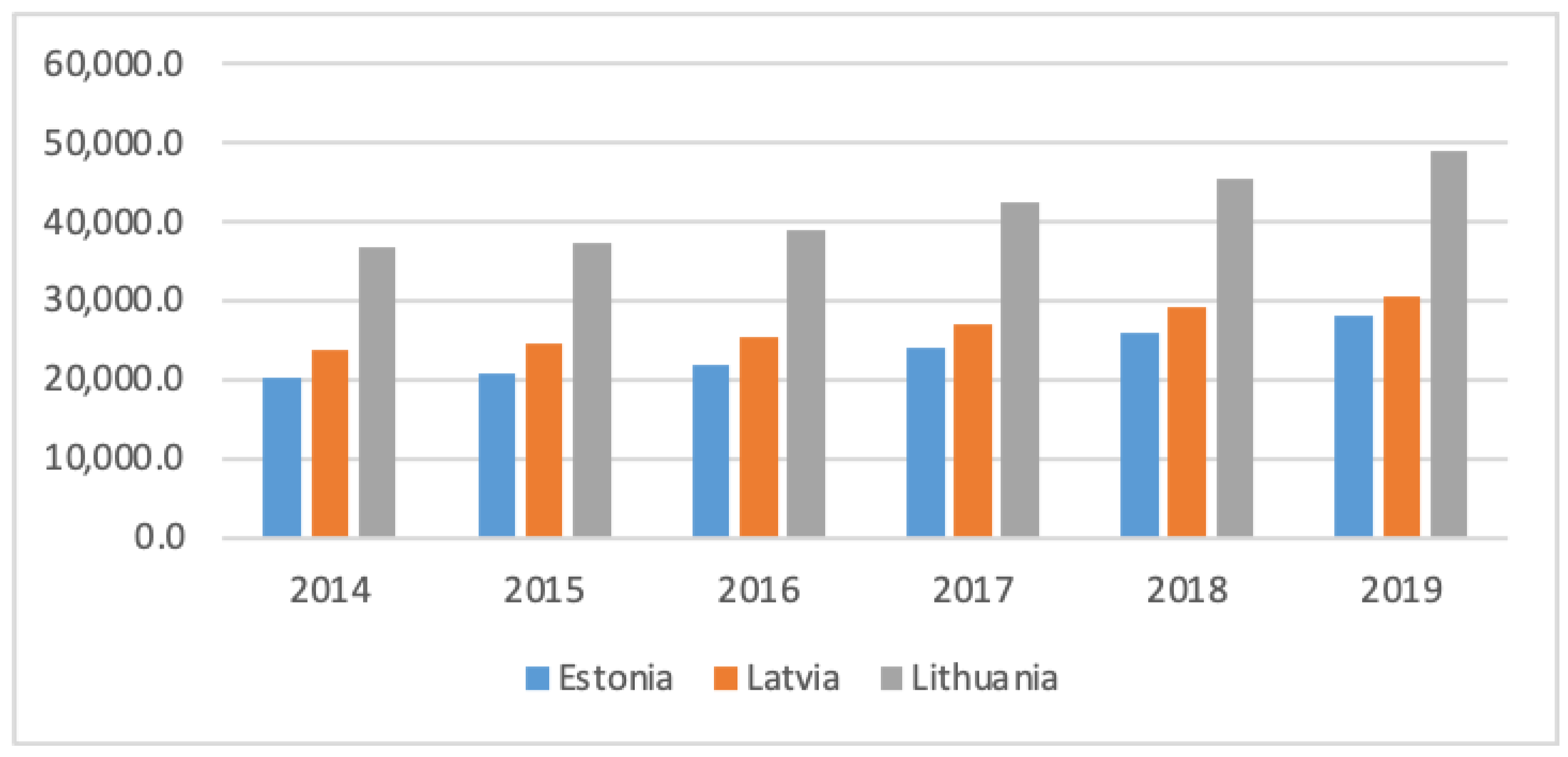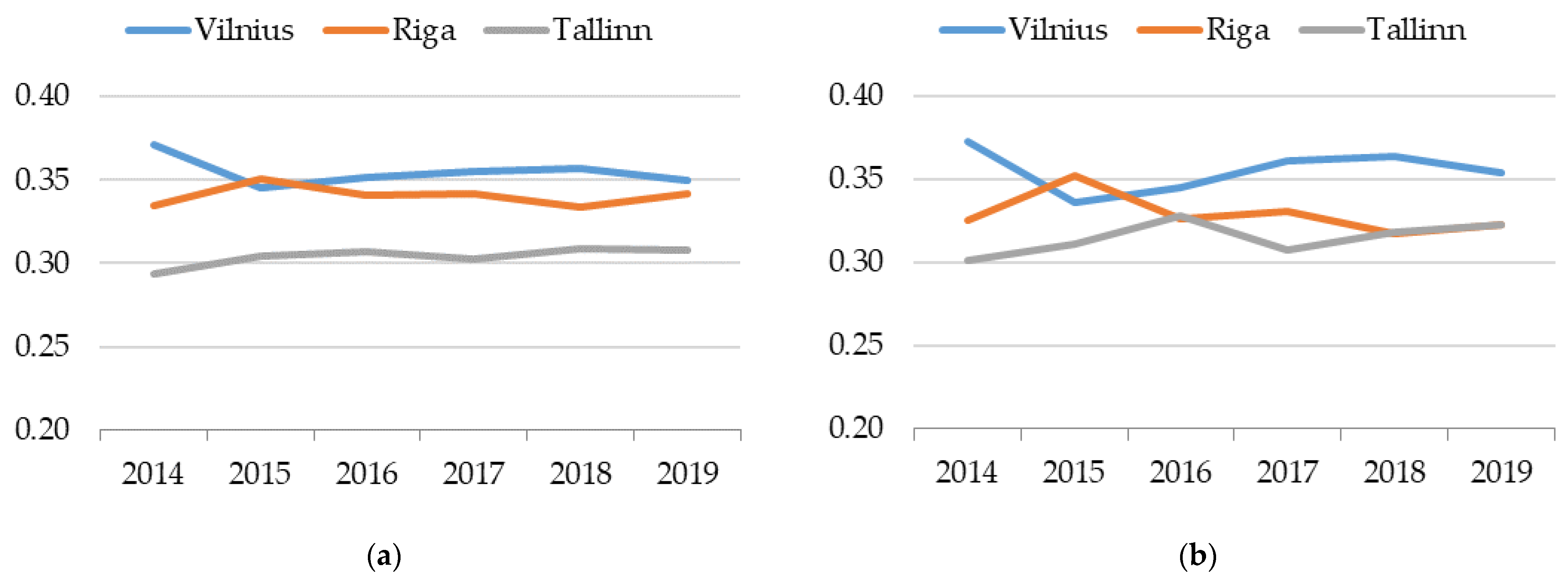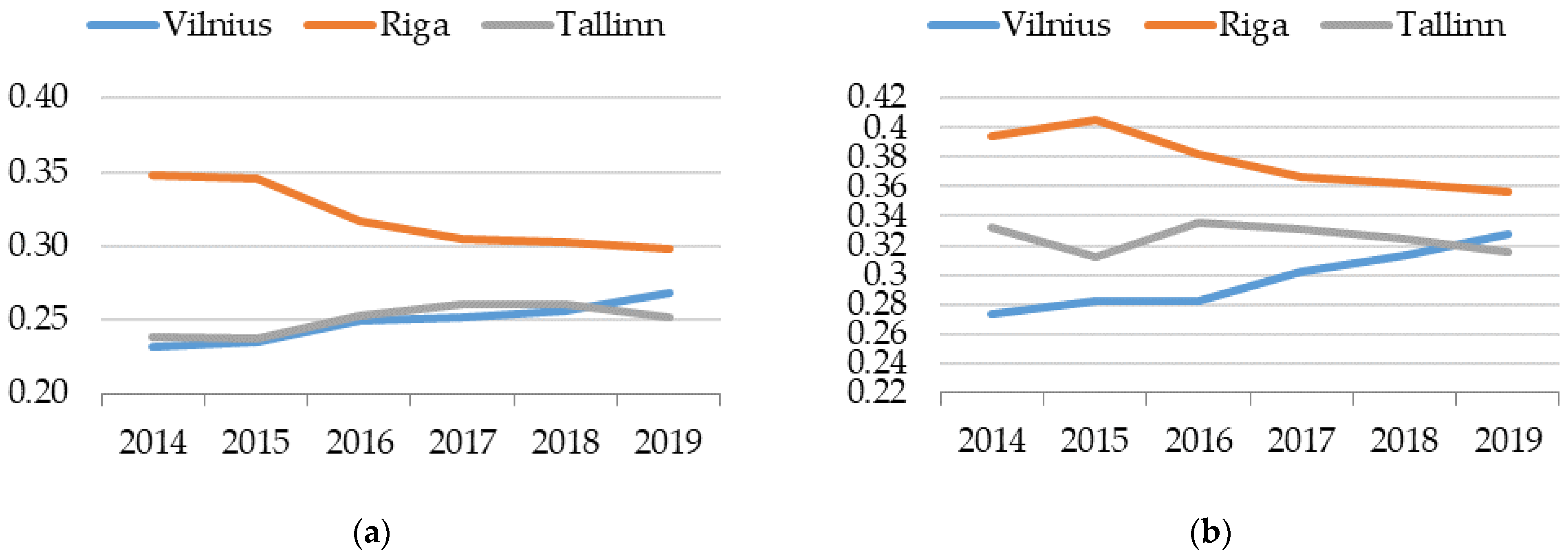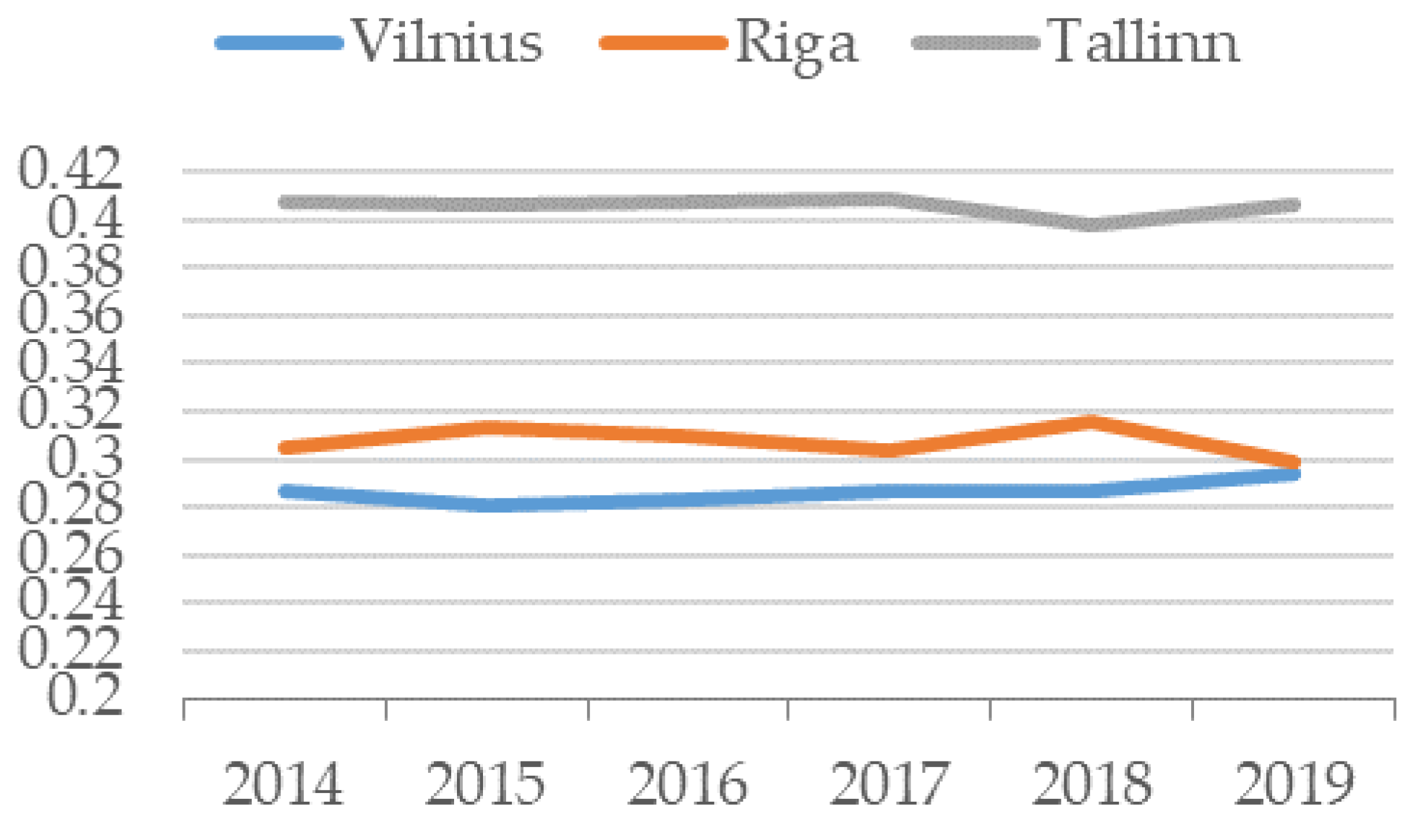An Integrated Competitiveness Assessment of the Baltic Capitals Based on the Principles of Sustainable Development
Abstract
1. Introduction
2. Analysis of Related Literature
2.1. The Concept of Competitiveness in Urban Areas
2.2. Urban Competitiveness Assessment
- Indices measuring the overall competitiveness of a country or a region. The most well-known indices in this group include the Global Competitiveness Index of the World Economic Forum and the Global Competitiveness Index of the Institute for Management Development.
- Indices measuring the partial competitiveness of a country or a region. The most well-known indices of this group include the Economic Freedom and Transparency International Corruption Perceptions Index.
- Indices assessing urban competitiveness.
- M40 is a rating of the city’s sustainable competitiveness
- M31 is a rating of the city’s gross domestic product
- M32 is a rating of the urban life quality
- M10 is a rating of the basic factors
- M20 is a rating of the developmental factors
- M50 is a rating of the external urban environment
- w1 … n are the weighting factors
3. Methodology
- xij is the value of the ith variable evaluation by the jth expert.
- the sum of the ranks of the jth city, i.e., =Rx1 + Rx2 +…. + Rxk
- n is the sample size;
- Sj is the multi-criteria assessment value of the jth alternative;
- ωi is the weight of the ith indicator;
- rij is the normalised value of the ith indicator to the jth alternative (6)
- rij is the value of the ith indicator to the jth object.
- ωi is the weight of the ith indicator;
- rij is the normalised value of the ith indicator to the jth object.
4. Research Results
- M12 is the factor value of the urban transportation infrastructure
- M18 is the factor value of the information and communications technology infrastructure
- M110 is the factor value of the city’s demographical situation
- M17 is the factor value of the social, cultural and sports infrastructure
- M19 is the factor value of the healthcare infrastructure
- M16 is the factor value of the sewage treatment system
- M111 is the factor value of the educational system
- M23 is the factor value of the city’s economic power
- M24 is the factor value of the competitiveness of the city companies
- M27 is the factor value of the city’s touristic appeal
- M28 is the factor value of the city’s investment appeal
- M29 is the factor value of workforce adaptability to changing conditions
- M210 is the factor value of city living convenience
- M211 is the factor value of environmental pollution
- M212 is the factor value of the human capital
- M213 is the factor value of migration
- M215 is the factor value of safety in the city
- M216 is the factor value of community learning, partnership and active involvement
- IM30 is the ranking at level III
- M31 is the factor value of GDP
- M32 is the factor value of the quality of life
5. Discussion
6. Conclusions
- The concept of urban competitiveness is regarded as the ability of cities to use certain available competitive factors that are created or drawn by the city to ensure the success of its economic, social and environmental systems and to maintain and strengthen the city’s competitive position in relation to both the other competing cities and time. This definition allows urban competitiveness to be perceived as a continuous and self-reinforcing process, rather than a finite result, whereby the result also becomes an input that later determines the outcome.
- We observed that the research into urban competitiveness assessment methods as found in the scientific literature demonstrates a variety of approaches. Some authors assessed urban competitiveness by employing one or more indicators; others developed theoretical models of urban competitiveness that combine a particular set of quantitative and qualitative indicators; and others still assessed it as an index or formulated various mathematical equations. There are many methods for assessing urban competitiveness, which stimulates much debate that aims to assess urban competitiveness objectively. It is especially difficult to assess its less studied aspects.
- The results obtained from assessing the overall competitiveness of the Baltic capitals according to the urban competitiveness assessment model based on the principles of sustainable development with the application of the SAW and COPRAS multi-criteria assessment methods suggest that Vilnius is in the lead in the entire period, followed by Riga that ranks second, and Tallinn that ranks third.
- Sensitivity and robustness analysis of the small city competitiveness assessment results showed that the assessment results using different multi-criteria assessment methods, i.e., SAW or COPRAS, differ only slightly.
Author Contributions
Funding
Institutional Review Board Statement
Informed Consent Statement
Data Availability Statement
Conflicts of Interest
References
- Singhal, S.; Berry, J.; McGreal, S. A Framework for Assessing Regeneration, Business Strategies and Urban Competitiveness. Local Econ. J. Local Econ. Policy Unit 2009, 24, 111–124. [Google Scholar] [CrossRef]
- Xu, B.; Watada, J. Identification of regional urbanization gap: Evidence of China. J. Model. Manag. 2008, 3, 7–25. [Google Scholar] [CrossRef]
- Henderson, J.-V.; Storeygard, A.; Weil, D.V. Measuring Economic Growth from Outer Space. Am. Econ. Rev. 2012, 102, 994–1028. [Google Scholar] [CrossRef] [PubMed]
- Witcher, P. The World Urban Forum: Ideas on the Future of the World’s Cities. UN Chron. 2006, 43, 30. [Google Scholar]
- Sun, C.; Luo, Y.; Li, J. Urban traffic infrastructure investment and air pollution: Evidence from the 83 cities in China. J. Clean. Prod. 2018, 172, 488–496. [Google Scholar] [CrossRef]
- Wang, J.; Shen, L.; Ren, Y.; Ocha, J.-J. A lessons mining system for searching references to support decision making towards sustainable urbanization. J. Clean. Prod. 2019, 209, 451–460. [Google Scholar] [CrossRef]
- Wang, J.; Wei, X.; Guo, Q. A three-dimensional evaluation model for regional carrying capacity of ecological environment to social economic development: Model development and a case study in China. Ecol. Indic. 2018, 89, 348–355. [Google Scholar] [CrossRef]
- Li, S.; Feng, K.; Li, M. Identifying the main contributors of air pollution in Beijing. J. Clean. Prod. 2017, 163, S359–S365. [Google Scholar] [CrossRef]
- Golzarpoor, H.; González, V.; Shahbazpour, M.; O’Sullivan, M. An input-output simulation model for assessing production and environmental waste in construction. J. Clean. Prod. 2017, 143, 1094–1104. [Google Scholar] [CrossRef]
- Akizu-Gardoki, O.; Bueno, G.; Wiedm, T. Decoupling between human development and energy consumption within footprint accounts. J. Clean. Prod. 2018, 202, 1145–1157. [Google Scholar] [CrossRef]
- Žalevičienė, A.; Čiegis, R. Darnus miestų vystymasis ir europos sąjungos investicijų įsisavinimas. Manag. Theory Stud. Rural Bus. Infrastruct. Dev. 2012, 1, 42–51. [Google Scholar]
- Ramanauskienė, J.; Čiegis, R. Integruotas darnaus vystymosi vertinimas: Lietuvos atvejis. Vadyb. Moksl. Ir Stud. -Kaimo Verslų Ir Jų Infrastruktūros Plėtrai 2011, 2, 39–49. [Google Scholar]
- Rutkauskas, A.-V. On the sustainability of regional competitiveness development considering risk. Technol. Econ. Dev. Econ. 2008, 14, 89–99. [Google Scholar] [CrossRef]
- Wei, Y.; Huang, C.; Lam, P.T.I.; Yuan, Z. Sustainable urban development: A review on urban carrying capacity assessment. Habitat Int. 2015, 46, 64–71. [Google Scholar] [CrossRef]
- Campagnolo, L.; Carraro, C.; Eboli, F.; Farnia, L.; Parrado, R.; Pierfederici, R. The Ex-Ante Evaluation of Achieving Sustainable Development Goals. Soc. Indic. Res. 2018, 136, 73–116. [Google Scholar] [CrossRef]
- Pivorienė, J. Global Education and Social Dimension of Sustainable Development. Soc. Ugdym. 2014, 39, 39–47. [Google Scholar] [CrossRef]
- Cioca, L.-I.; Ivascu, L.; Rada, E.; Torretta, V.; Ionescu, G. Sustainable Development and Technological Impact on CO2 Reducing Conditions in Romania. Sustainability 2015, 7, 1637–1650. [Google Scholar] [CrossRef]
- Bruneckienė, J. Šalies Regionų Konkurencingumo Vertinimas Įvairiais Metodais: Rezultatų Analizė Ir Vertinimas. Econ. Manag. 2010, 15, 25–31. [Google Scholar]
- Sinkienė, J. Miesto konkurencingumo veiksniai. Viešoji Polit. ir Adm. 2008, 25, 68–83. [Google Scholar]
- Ni, P.; Kresl, P.; Li, X. China urban competitiveness in industrialization: Based on the panel data of 25 cities in China from 1990 to 2009. Urban Stud. 2014, 51, 2787–2805. [Google Scholar] [CrossRef]
- Cuadrado-Roura, J.-R.; Maroto, A. Unbalanced regional resilience to the economic crisis in Spain: A tale of specialisation and productivity, Cambridge. J. Reg. Econ. Soc. 2016, 9, 153–178. [Google Scholar] [CrossRef]
- Jeney, L. Key factors of urban competitiveness in East Central European space structure. In Proceedings of the Regional Studies Association Annual International Conference, Budapest, Hungary, 24–26 May 2010. [Google Scholar]
- Činčikaitė, R.; Paliulis, N. Miesto konkurencingumo sąvokos ir jį lemiančių veiksnių analizė. Ekonomika ir Vadyba 2011, 16, 258–265. [Google Scholar]
- Činčikaitė, R.; Paliulis, N. Assessing Competitiveness of Lithuanian Cities. Econ. Manag. 2013, 18, 490–500. [Google Scholar] [CrossRef][Green Version]
- Pabedinskaitė, A.; Karlas, A.; Činčikaitė, R. Evaluation of smart cities. Manag. Eng. 2016, 1, 273–283. [Google Scholar]
- Pabedinskaitė, A.; Činčikaitė, R. Peculiarities of evaluating urban competitiveness. Manag. Eng. 2015, 1, 475–483. [Google Scholar]
- Bruneckiene, J.; Činčikaitė, R.; Kilijonienė, A. The Specifics of Measurement the Urban Competitiveness at the National and International Level. Eng. Econ. 2012, 23, 256–270. [Google Scholar] [CrossRef]
- Bruneckiene, J.; Guzavicius, A.; Cincikaite, R. Measurement of Urban Competitiveness in Lithuania. Eng. Econ. 2010, 21, 493–508. [Google Scholar]
- Webster, D.; Muller, L. Urban Competitiveness Assessment in Developing Country Urban Regions: The Road Forward, Urban Group; The World Bank: Washington, DC, USA, 2000; pp. 1–47. [Google Scholar]
- Piliutytė, J. Miestų konkurencingumo koncepcija ir analizės lygmenys. Viešoji Polit. ir Adm. 2007, 19, 81–89. [Google Scholar]
- Shen, J.; Yang, X. Analyzing Urban Competitiveness Changes in Major Chinese Cities 1995–2008. Appl. Spat. Anal. Policy 2014, 7, 361–379. [Google Scholar] [CrossRef]
- Bakıcı, T.; Almirall, E.; Wareham, J. A Smart City Initiative: The Case of Barcelona. J. Knowl. Econ. 2013, 4, 135–148. [Google Scholar] [CrossRef]
- Anttiroiko, A.V.; Valkama, P.; Bailey, S.-J. Smart cities in the new service economy: Building platforms for smart services. AI Soc. 2014, 29, 323–334. [Google Scholar] [CrossRef]
- Auci, S.; Mundula, L. Smart Cities and a Stochastic Frontier Analysis: A Comparison among European Cities. SSRN Electron. J. 2012. Available online: http://ssrn.com/abstract=2150839 (accessed on 5 February 2021).
- Bojic, I.; Lipic, T.; Podobnik, V. Bio-inspired Clustering and Data Diffusion in Machine Social Networks. In Computational Social Networks; Springer: London, UK, 2012; pp. 51–79. [Google Scholar]
- Fernandez-Anez, V.; Fernández-Güell, J.-M.; Giffinger, R. Smart City implementation and discourses: An integrated conceptual model. The case of Vienna. Cities 2018, 78, 4–16. [Google Scholar] [CrossRef]
- Caragliu, A.; Del Bo, C.; Nijkamp, P. Smart Cities in Europe. J. Urban Technol. 2011, 18, 65–82. [Google Scholar] [CrossRef]
- Valstybės Pažangos Strategija Lietuvos Pažangos Strategija “Lietuva 2030”. Available online: https://e-seimas.lrs.lt/portal/legalAct/lt/TAD/TAIS.425517 (accessed on 5 February 2021).
- Lietuvos Respublikos Regioninės Plėtros Įstatymas. 2020. Available online: https://e-seimas.lrs.lt/portal/legalAct/lt/TAD/ab78cdf0b15c11ea9a12d0dada3ca61b (accessed on 5 February 2021).
- European Innovation Partnership on Smart Cities and Communities Operational Implementation Plan: First Public Draft. Available online: https://www.interregeurope.eu/fileadmin/user_upload/tx_tevprojects/library/operational-implementation-plan-oip-v2_en.pdf (accessed on 5 February 2021).
- Ramanauskas, G. Evaluation of International Competitiveness. Èkonomika 2004, 68, 91–112. [Google Scholar] [CrossRef]
- Hák, T.; Janoušková, S.; Moldan, B. Sustainable Development Goals: A need for relevant indicators. Ecol. Indic. 2016, 60, 565–573. [Google Scholar] [CrossRef]
- Shaaban, M.; Scheffran, J. Selection of sustainable development indicators for the assessment of electricity production in Egypt. Sustain. Energy Technol. Assess. 2017, 22, 65–73. [Google Scholar] [CrossRef]
- Biermann, F.; Kanie, N.; Kim, R.-E. Global governance by goal-setting: The novel approach of the UN Sustainable Development Goals. Curr. Opin. Environ. Sustain. 2017, 26–27, 26–31. [Google Scholar] [CrossRef]
- Xavier, A.; Freitas, M.; Fragoso, R.; Rosário, M. A regional composite indicator for analysing agricultural sustainability in Portugal: A goal programming approach. Ecol. Indic. 2018, 89, 84–100. [Google Scholar] [CrossRef]
- Ginevičius, R.; Podvezko, V.; Mikelis, D. Quantitative Evaluation of Economic and Social Development of Lithuanian Regions. Ekonomika 2004, 65. [Google Scholar] [CrossRef]
- Zavadskas, E.-K.; Turskis, Z. Multiple criteria decision making (mcdm) methods in economics: An overview / daugiatiksliai sprendimų priėmimo metodai ekonomikoje: Apžvalga. Technol. Econ. Dev. Econ. 2011, 17, 397–427. [Google Scholar] [CrossRef]
- Li, F.; Liu, X.; Hu, D.; Wang, R.; Yang, W. Measurement indicators and an evaluation approach for assessing urban sustainable development: A case study for China’s Jining City. Landsc. Urban Plan. 2009, 90, 134–142. [Google Scholar] [CrossRef]
- Lazauskas, M.; Zavadskas, E.-K.; Šaparauskas, J. Ranking of priorities among the baltic capital cities for the development of sustainable construction. Econ. Manag. 2015, 18, 15–24. [Google Scholar] [CrossRef]
- Akande, A.; Cabral, P.; Gomes, P.; Casteleyn, S. Lisbon ranking for smart sustainable cities in Europe. Sustain. Cities Soc. 2019, 44, 475–487. [Google Scholar] [CrossRef]
- Stanković, J.; Džunić, M.; Džunić, Ž.; Marinković, S. A multi-criteria evaluation of the european cities’ smart performance: Economic, social and environmental aspects. J. Econ. Bus. 2017, 35, 519–550. [Google Scholar] [CrossRef]
- Rodríguez Bolívar, M.-P. In the search for the ‘Smart’ Source of the Perception of Quality of Life in European Smart Cities. In Proceedings of the 52nd Hawaii International Conference on System Sciences, Maui, HI, USA, 8–11 January 2019. [Google Scholar] [CrossRef]
- Gil, M.T.N.; Carvalho, L.; Paiva, I. Determining factors in becoming a sustainable smart city: An empirical study in Europe. Econ. Sociol. 2020, 13, 24–39. [Google Scholar] [CrossRef]
- Barão, M.V.H.C.; Ferreira, F.A.F.; Spahr, R.W.; Sunderman, M.A.; Govindan, K.; Meidutė-Kavaliauskienė, I. Strengthening urban sustainability: Identification and analysis of proactive measures to combat blight. J. Clean. Prod. 2021, 292, 126026. [Google Scholar] [CrossRef]
- Meidutė-Kavaliauskienė, I.; Dudzevičiūtė, G.; Maknickienė, N. Military and Demographic inter-linkages in the context of the Lithuanian sustainability. J. Bus. Econ. Manag. 2020, 6, 1508–1524. [Google Scholar] [CrossRef]
- Assunção, E.R.G.T.R.; Ferreira, F.A.F.; Meidutė-Kavaliauskienė, I.; Zopounidis, C.; Pereira, L.F.; Correia, R.J.C. Rethinking urban sustainability using fuzzy cognitive mapping and system dynamics. Int. J. Sustain. Dev. World Ecol. 2020, 27, 261–275. [Google Scholar] [CrossRef]
- Estêvão, R.S.G.; Ferreira, F.A.F.; Rosa, Á.A.; Govindan, K.; Meidutė-Kavaliauskienė, I. A socio-technical approach to the assessment of sustainable tourism: Adding value with a comprehensive process-oriented framework. J. Clean. Prod. 2019, 236, 117487. [Google Scholar] [CrossRef]





| Country | GCI Years 2018–2011 | GCI Years 2009–2010 | Position Changes in the Ranking (+/−) | IWCI Year 2018 | IWCI Year 2019 | Position Changes in the Ranking (+/−) |
|---|---|---|---|---|---|---|
| Raking | Ranking | |||||
| Estonia | 31 | 32 | +1 | 31 | 35 | −4 |
| Lithuania | 39 | 40 | +1 | 32 | 29 | +3 |
| Latvia | 41 | 42 | +1 | 40 | 40 | - |
| COPRAS | ||||||
| 2014 | 2015 | 2016 | 2017 | 2018 | 2019 | |
| r | 0.996718 | 0.987961 | 0.925231 | 0.999308 | 0.968269 | 0.881032 |
| t krit | 12.7062 | |||||
| t lent | 12.31203 | 6.386269 | 2.43864 | 26.86959 | 3.874479 | 1.862427 |
| SAW | ||||||
| r | 0.976225 | 0.993104 | 0.825197 | 0.838476 | 0.721684 | 0.628853 |
| t lent | 4.503677 | 8.470904 | 1.460924 | 1.538664 | 1.04256 | 0.808789 |
Publisher’s Note: MDPI stays neutral with regard to jurisdictional claims in published maps and institutional affiliations. |
© 2021 by the authors. Licensee MDPI, Basel, Switzerland. This article is an open access article distributed under the terms and conditions of the Creative Commons Attribution (CC BY) license (http://creativecommons.org/licenses/by/4.0/).
Share and Cite
Činčikaitė, R.; Meidute-Kavaliauskiene, I. An Integrated Competitiveness Assessment of the Baltic Capitals Based on the Principles of Sustainable Development. Sustainability 2021, 13, 3764. https://doi.org/10.3390/su13073764
Činčikaitė R, Meidute-Kavaliauskiene I. An Integrated Competitiveness Assessment of the Baltic Capitals Based on the Principles of Sustainable Development. Sustainability. 2021; 13(7):3764. https://doi.org/10.3390/su13073764
Chicago/Turabian StyleČinčikaitė, Renata, and Ieva Meidute-Kavaliauskiene. 2021. "An Integrated Competitiveness Assessment of the Baltic Capitals Based on the Principles of Sustainable Development" Sustainability 13, no. 7: 3764. https://doi.org/10.3390/su13073764
APA StyleČinčikaitė, R., & Meidute-Kavaliauskiene, I. (2021). An Integrated Competitiveness Assessment of the Baltic Capitals Based on the Principles of Sustainable Development. Sustainability, 13(7), 3764. https://doi.org/10.3390/su13073764







